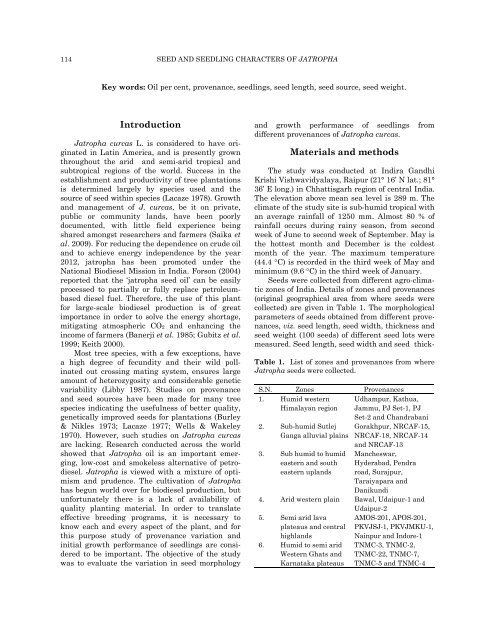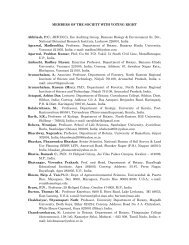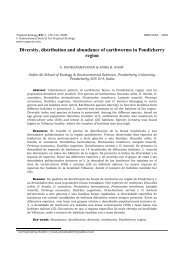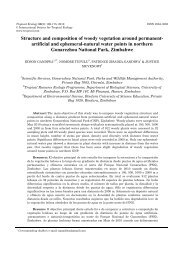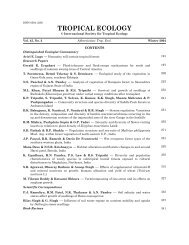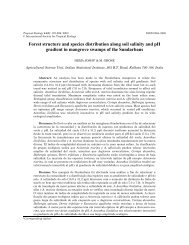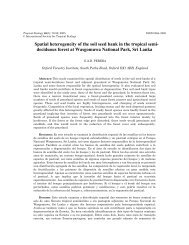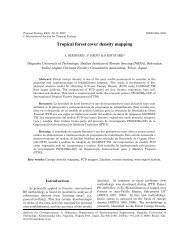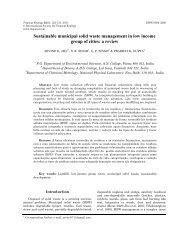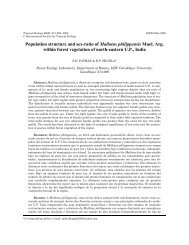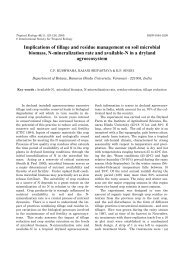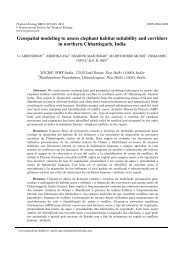Variation in seed and seedling characters of Jatropha curcas L. with ...
Variation in seed and seedling characters of Jatropha curcas L. with ...
Variation in seed and seedling characters of Jatropha curcas L. with ...
You also want an ePaper? Increase the reach of your titles
YUMPU automatically turns print PDFs into web optimized ePapers that Google loves.
114 SEED AND SEEDLING CHARACTERS OF JATROPHA<br />
Key words: Oil per cent, provenance, <strong>seed</strong>l<strong>in</strong>gs, <strong>seed</strong> length, <strong>seed</strong> source, <strong>seed</strong> weight.<br />
Introduction<br />
<strong>Jatropha</strong> <strong>curcas</strong> L. is considered to have orig<strong>in</strong>ated<br />
<strong>in</strong> Lat<strong>in</strong> America, <strong>and</strong> is presently grown<br />
throughout the arid <strong>and</strong> semi-arid tropical <strong>and</strong><br />
subtropical regions <strong>of</strong> the world. Success <strong>in</strong> the<br />
establishment <strong>and</strong> productivity <strong>of</strong> tree plantations<br />
is determ<strong>in</strong>ed largely by species used <strong>and</strong> the<br />
source <strong>of</strong> <strong>seed</strong> <strong>with</strong><strong>in</strong> species (Lacaze 1978). Growth<br />
<strong>and</strong> management <strong>of</strong> J. <strong>curcas</strong>, be it on private,<br />
public or community l<strong>and</strong>s, have been poorly<br />
documented, <strong>with</strong> little field experience be<strong>in</strong>g<br />
shared amongst researchers <strong>and</strong> farmers (Saika et<br />
al. 2009). For reduc<strong>in</strong>g the dependence on crude oil<br />
<strong>and</strong> to achieve energy <strong>in</strong>dependence by the year<br />
2012, jatropha has been promoted under the<br />
National Biodiesel Mission <strong>in</strong> India. Forson (2004)<br />
reported that the ‘jatropha <strong>seed</strong> oil’ can be easily<br />
processed to partially or fully replace petroleumbased<br />
diesel fuel. Therefore, the use <strong>of</strong> this plant<br />
for large-scale biodiesel production is <strong>of</strong> great<br />
importance <strong>in</strong> order to solve the energy shortage,<br />
mitigat<strong>in</strong>g atmospheric CO2 <strong>and</strong> enhanc<strong>in</strong>g the<br />
<strong>in</strong>come <strong>of</strong> farmers (Banerji et al. 1985; Gubitz et al.<br />
1999; Keith 2000).<br />
Most tree species, <strong>with</strong> a few exceptions, have<br />
a high degree <strong>of</strong> fecundity <strong>and</strong> their wild poll<strong>in</strong>ated<br />
out cross<strong>in</strong>g mat<strong>in</strong>g system, ensures large<br />
amount <strong>of</strong> heterozygosity <strong>and</strong> considerable genetic<br />
variability (Libby 1987). Studies on provenance<br />
<strong>and</strong> <strong>seed</strong> sources have been made for many tree<br />
species <strong>in</strong>dicat<strong>in</strong>g the usefulness <strong>of</strong> better quality,<br />
genetically improved <strong>seed</strong>s for plantations (Burley<br />
& Nikles 1973; Lacaze 1977; Wells & Wakeley<br />
1970). However, such studies on <strong>Jatropha</strong> <strong>curcas</strong><br />
are lack<strong>in</strong>g. Research conducted across the world<br />
showed that <strong>Jatropha</strong> oil is an important emerg<strong>in</strong>g,<br />
low-cost <strong>and</strong> smokeless alternative <strong>of</strong> petrodiesel.<br />
<strong>Jatropha</strong> is viewed <strong>with</strong> a mixture <strong>of</strong> optimism<br />
<strong>and</strong> prudence. The cultivation <strong>of</strong> <strong>Jatropha</strong><br />
has begun world over for biodiesel production, but<br />
unfortunately there is a lack <strong>of</strong> availability <strong>of</strong><br />
quality plant<strong>in</strong>g material. In order to translate<br />
effective breed<strong>in</strong>g programs, it is necessary to<br />
know each <strong>and</strong> every aspect <strong>of</strong> the plant, <strong>and</strong> for<br />
this purpose study <strong>of</strong> provenance variation <strong>and</strong><br />
<strong>in</strong>itial growth performance <strong>of</strong> <strong>seed</strong>l<strong>in</strong>gs are considered<br />
to be important. The objective <strong>of</strong> the study<br />
was to evaluate the variation <strong>in</strong> <strong>seed</strong> morphology<br />
<strong>and</strong> growth performance <strong>of</strong> <strong>seed</strong>l<strong>in</strong>gs from<br />
different provenances <strong>of</strong> <strong>Jatropha</strong> <strong>curcas</strong>.<br />
Materials <strong>and</strong> methods<br />
The study was conducted at Indira G<strong>and</strong>hi<br />
Krishi Vishwavidyalaya, Raipur (21° 16’ N lat.; 81°<br />
36’ E long.) <strong>in</strong> Chhattisgarh region <strong>of</strong> central India.<br />
The elevation above mean sea level is 289 m. The<br />
climate <strong>of</strong> the study site is sub-humid tropical <strong>with</strong><br />
an average ra<strong>in</strong>fall <strong>of</strong> 1250 mm. Almost 80 % <strong>of</strong><br />
ra<strong>in</strong>fall occurs dur<strong>in</strong>g ra<strong>in</strong>y season, from second<br />
week <strong>of</strong> June to second week <strong>of</strong> September. May is<br />
the hottest month <strong>and</strong> December is the coldest<br />
month <strong>of</strong> the year. The maximum temperature<br />
(44.4 °C) is recorded <strong>in</strong> the third week <strong>of</strong> May <strong>and</strong><br />
m<strong>in</strong>imum (9.6 °C) <strong>in</strong> the third week <strong>of</strong> January.<br />
Seeds were collected from different agro-climatic<br />
zones <strong>of</strong> India. Details <strong>of</strong> zones <strong>and</strong> provenances<br />
(orig<strong>in</strong>al geographical area from where <strong>seed</strong>s were<br />
collected) are given <strong>in</strong> Table 1. The morphological<br />
parameters <strong>of</strong> <strong>seed</strong>s obta<strong>in</strong>ed from different provenances,<br />
viz. <strong>seed</strong> length, <strong>seed</strong> width, thickness <strong>and</strong><br />
<strong>seed</strong> weight (100 <strong>seed</strong>s) <strong>of</strong> different <strong>seed</strong> lots were<br />
measured. Seed length, <strong>seed</strong> width <strong>and</strong> <strong>seed</strong> thick-<br />
Table 1. List <strong>of</strong> zones <strong>and</strong> provenances from where<br />
<strong>Jatropha</strong> <strong>seed</strong>s were collected.<br />
S.N. Zones Provenances<br />
1. Humid western<br />
Himalayan region<br />
Udhampur, Kathua,<br />
Jammu, PJ Set-1, PJ<br />
Set-2 <strong>and</strong> Ch<strong>and</strong>rabani<br />
2. Sub-humid Sutlej<br />
Ganga alluvial pla<strong>in</strong>s<br />
3. Sub humid to humid<br />
eastern <strong>and</strong> south<br />
eastern upl<strong>and</strong>s<br />
Gorakhpur, NRCAF-15,<br />
NRCAF-18, NRCAF-14<br />
<strong>and</strong> NRCAF-13<br />
Mancheswar,<br />
Hyderabad, Pendra<br />
road, Surajpur,<br />
Taraiyapara <strong>and</strong><br />
Danikundi<br />
4. Arid western pla<strong>in</strong> Bawal, Udaipur-1 <strong>and</strong><br />
Udaipur-2<br />
5. Semi arid lava<br />
plateaus <strong>and</strong> central<br />
highl<strong>and</strong>s<br />
AMOS-201, APOS-201,<br />
PKVJSJ-1, PKVJMKU-1,<br />
Na<strong>in</strong>pur <strong>and</strong> Indore-1<br />
6. Humid to semi arid<br />
Western Ghats <strong>and</strong><br />
Karnataka plateaus<br />
TNMC-3, TNMC-2,<br />
TNMC-22, TNMC-7,<br />
TNMC-5 <strong>and</strong> TNMC-4


